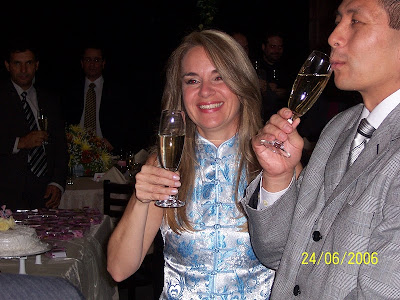Above we see my Si Mo Daniela Camacho(11G VT) dressing a cloth known as QiPao (旗袍) in mandarin, and in cantonese, the dialect from the part of China where Ving Tsun came from is "Kei Po"
ACOMPANHE OS ESPECIAIS ANTERIORES SOBRE AS ROUPAS DO KUNG FU COM DESENHOS DE GRÃO-MESTRE MOY YAT :
KNOW MORE ABOUT CHINESE CLOTHES WITH GRAND MASTER MOY YAT´S DRAWINGS:
- PARTE 1[PART ONE](AQUI/HERE)
- PARTE 2[PART TWO] (AQUI/HERE)
Vamos então chamar desta vez de QiPao(旗袍) mesmo.
Lets call as QiPao(旗袍):
A ORIGEM DA VESTIMENTA:
THE ORIGN OF THE DRESS:
Si Fu Julio Camacho ao lado de sua esposa Daniela Camacho, usando o QiPao(旗袍).
Leia a história de Si Mo Daniela Camacho na Familia Kung Fu [AQUI]
My Si Fu Julio Camacho(11G VT) and his wife, Si Mo Daniela(11G VT) , and she is dressing a
QiPao(旗袍). again.
Read her story HERE
chèungsàam é a pronuncia em cantonês para:
chèungsàam is the pronunciation for:
长(chèung) - "longo" (long)
衫(sàam) - "Vestido". (dress)
Essa é a pronuncia em cantonês para o termo no dialeto de ShangHai "zǎnze"(长衫) , que contrasta com o termo chángshān(长衫) em mandarim, que se refere a uma vestimenta exclusivamente masculina enquanto QiPao(旗袍) seria o equivalente feminino. Acontece , que esta vestimenta de origem Manchu, foi usada pela primeira vez por mulheres "Han"(汉) por estudantes de ShangHai.
Além disso, quando alfaiates de ShangHai fugiram para Hong Kong depois da Revolução Comunista passaram a usar chèungsàam tanto para vestes masculinas quanto para femininas, e QiPao[Kei Po](旗袍) seria um termo mais formal.
Si Taai Vanise Imamura durante brinde com Si Gung Leo Imamura.
Si Taai Vanise Imamura(10G VT) and her husband,my Si Gugn Leo Imamura.
Ao longo dos anos, esta vestimenta Manchu sofreu alterações, onde nos anos 30 se tornou mais justa ao corpo, seguindo padrões ocidentais da época. Nos anos 40 se tornou finalmente a vestimenta padrão das mulheres chinesas em ocasiões especiais ao redor do mundo.
Trough the years, this cloth changed a lot , in the 30´s the cloth became more western , and in the 40´s became the standard cloth for chinese women around the world during special ocasions.
Diferentes tipos de QiPao em ilustração de Fu Chunjiang, no livro Cultura Chinesa, da Editora Roca(2007)
Different QiPao by Fu Chunjiang in the book of Chinese Culture, Roca(2007)
Thiago Pereira,12G VT moyfatlei.myvt@gmail.com
MOY YAT VING TSUN NUCLEO RIO DE JANEIRO (BARRA/MEIER/COPACABANA)
3150-5148
![[詠春武林中外]](https://blogger.googleusercontent.com/img/a/AVvXsEgnBEYjqil7bWijBNjC4yuXT2bWBzR6kHRlBR9DE2Z_sOkSX1y41ZPaIyALWPwZLcpwUmtD0nxste7XeWrY8CxXEBrF_kdWA8ZlSeL6YBa00RHxvnrS1YR8z9vCltEFVW-DyS9-owHi4JI7SgEMSXP9t1mjNxwnstfmsXT9vxHvitvvbyKWlnYcSLBJk4o=s1040)



